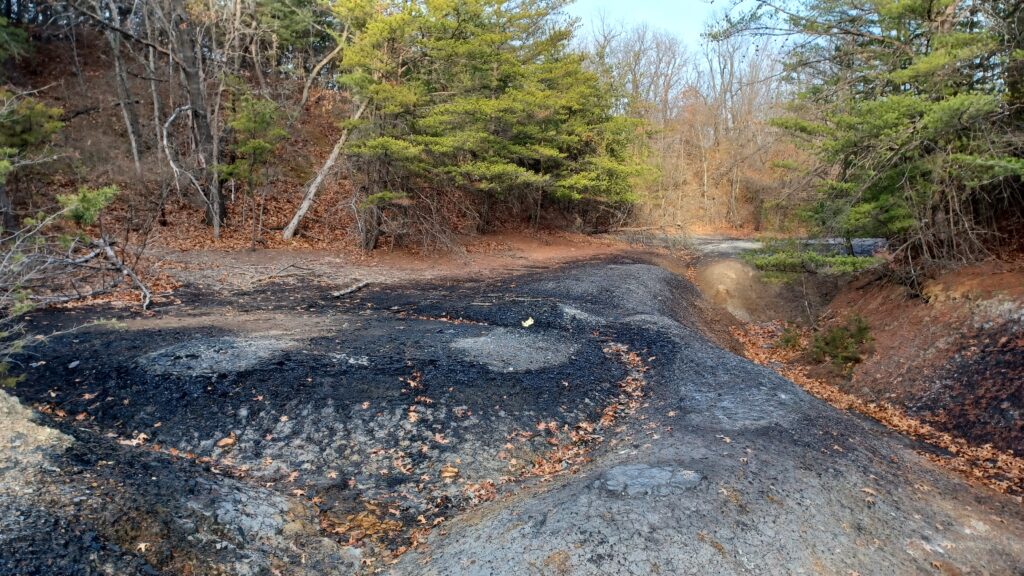Land in the Pella Wildlife Area (pictured) is part of an abandoned coal mine that the Iowa Department of Agriculture and Land Stewardship is reclaiming. (Photo courtesy of Iowa DNR)
The Iowa Department of Agriculture and Land Stewardship embarked this month on a 162-acre abandoned mine land reclamation project in the Pella Wildlife Area. This is one of about 120 reclamation projects that have taken place in Iowa since the 1980s, several of which have garnered national recognition for their ingenuity.
Coal mining was a short but significant part of Iowa’s history. When the miners left midway through the 20th century, there was no regulation in place to ensure they cleaned up the land.
The result is that sites like the one near Pella have acid soils that are largely unsupportive of native plants, huge sloping mounds of soil and pits, often filled with similarly inhospitable water.
“You look at it, and currently it’s basically like an ecological disaster right now,” said Todd Gosselink, a wildlife biologist with Iowa Department of Natural Resources.
Gosselink helps manage the Pella Wildlife Area, which has been owned by DNR since the 1950s after the strip mining company left the area. Gosselink said invasive species, like honeysuckle and Japanese raspberry, have “taken advantage” and taken over the “highly disturbed” areas.
There are some wetland areas that have frogs and critters, and others have clear, lifeless water.
“There’s some major water quality issues,” Gosselink said
DNR has worked to prepare the site since 2021, clearing trees, invasive species and planting new trees in the middle area. The north portion of the site is closed currently and the rest of the wildlife area will close in November as the abandoned mine land restoration begins.
The abandoned mine land restoration program with IDALS allocated nearly $4 million to neutralize the soil with 7,000 tons of lime, mitigate clogged waterways, move over a million cubic yards of earthwork and “return the site back to pre-mining conditions,” a press release said.
“It’s going to have much more diversity, and it’s gonna be more usable for wildlife, but also people,” Gosselink said.
An aerial photo of Pella Wildlife Area shows the cratered topography left from coal strip mining in the 1930s through 1950s. (Graphic courtesy of Iowa DNR)
A leader in mine land reclamation projects
Pella is the largest abandoned mine land reclamation project that the department has done. It was announced Oct. 2 along with six other projects, all in southeast Iowa, where most of the mining in the state occurred.
Coal mining in Iowa declined in the 1920s and most mines closed in the 1950s.
Reclamation of these abandoned areas began in Iowa in 1983 following the federal Surface Mining Control and Reclamation Act of 1977. The program uses federal money collected from active coal mines to restore these lands and to date, an estimated $103 million have been invested in Iowa’s program.
Susan Kozak, director of IDALS’ soil conservation and water quality division, said compared to other states, Iowa doesn’t have a lot of abandoned mine sites.
“But nationally, Iowa is viewed as a leader, because we have won so many awards (and) we try different things,” Kozak said. “We have a really good group of people that are passionate about this.”
The state has won eight awards from the Office of Surface Mining, Reclamation and Enforcement. Kozak said each project is completely different depending on the site, its natural topography and the desires of the land owner.
Past projects have turned the hazardous abandoned sites into native prairies full of pollinators, or into a low-use pasture, as the sites are fairly fragile after a reclamation project.
“When we get done reclaiming them, we’ve just created a surface layer that has some vegetation, has some natural pH brought back to it, and some organic matter,” Kozak said. “But it has to be managed very carefully, or it’ll just go right back to being spoiled material.”
Untouched mine sites have pH levels so acidic that Kozak said an intern once came back with her nail polish stripped after taking water samples.
“We call it acid mine drainage, and it’ll turn the water orange running off of the sites because of that chemical reaction,” Kozak said. “ So that’s our job to clean that up.”
The sites are also highly susceptible to erosion because of the steep slopes and lack of vegetation.
Iowa has more than 13,000 acres of abandoned mine land. The department has reclaimed 120 sites and currently has more than 30 sites in the planning or construction phase. There are 140 sites awaiting reclamation.
The project at the Pella Wildlife Area is expected to be completed in spring 2026 and reopened to the public in summer 2026.
YOU MAKE OUR WORK POSSIBLE.

